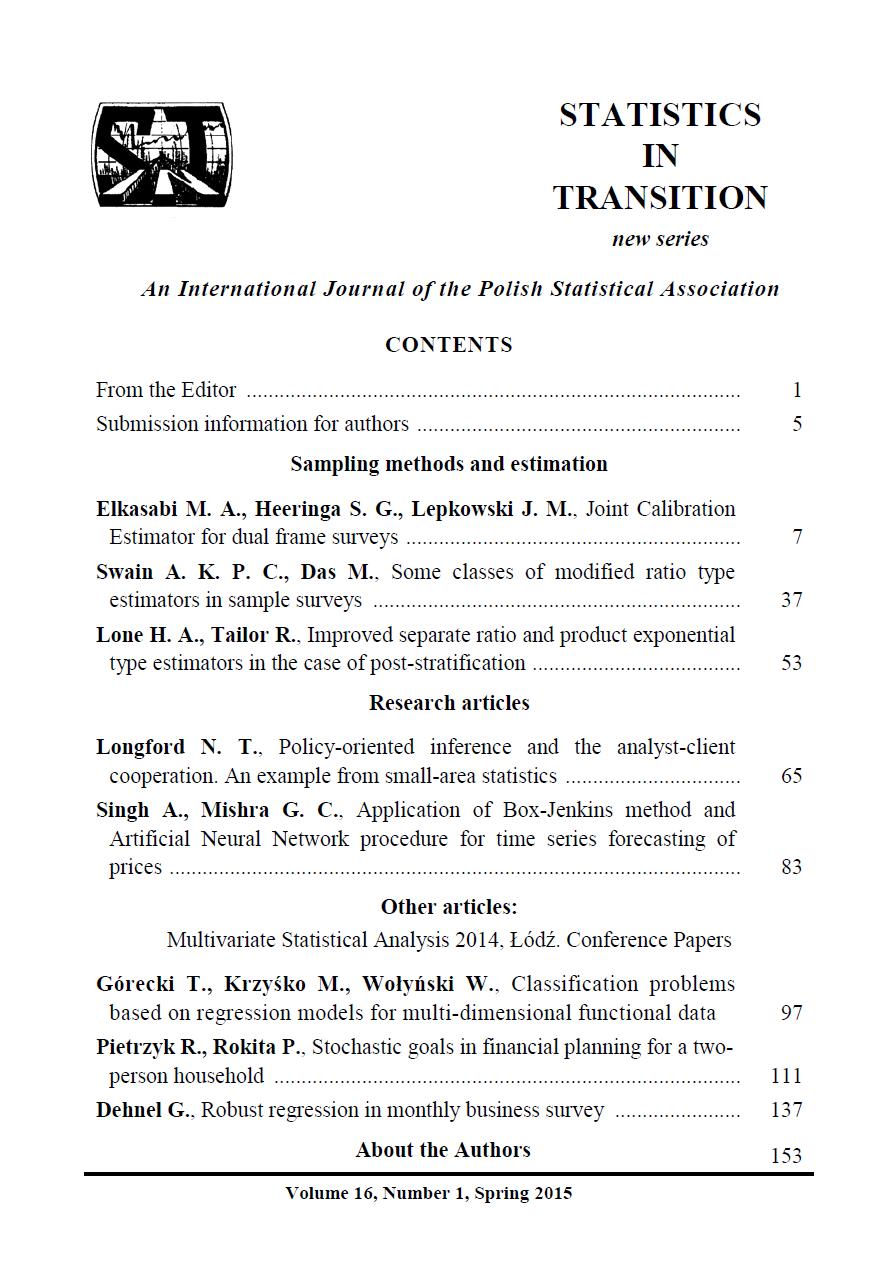ARTICLE
ABSTRACT
Many dual frame estimators have been proposed in the statistics literature. Some of these estimators are theoretically optimal but hard to apply in practice, whereas others are applicable but have larger variances than the first group. In this paper, a Joint Calibration Estimator (JCE) is proposed that is simple to apply in practice and meets many desirable properties for dual frame estimators. The JCE is asymptotically design unbiased conditional on the strong relationship between the estimation variable and the auxiliary variables employed in the calibration. The JCE achieves better performance when the auxiliary variables can fully explain the variability in the study variables or at least when the auxiliary variables are strong correlates of the estimation variables. As opposed to the standard dual frame estimators, the JCE does not require domain membership information. Even if included in the JCE auxiliary variables, the effect of the randomly misclassified domains does not exceed the random measurement error effect. Therefore, the JCE tends to be robust for the misclassified domains if included in the auxiliary variables. Meanwhile, the misclassified domains can significantly affect the unbiasedness of the standard dual frame estimators as proved theoretically and empirically in this paper.
KEYWORDS
dual-frame estimation, calibration weighting, auxiliary variables, domain misclassification
REFERENCES
BANKIER, M. D., (1986). Estimators Based on Several Stratified Samples with Applications to Multiple Frame Surveys, Journal of the American Statistical Association, 81, 1074-1079.
BRICK, J. M., DIPKO, S., PRESSER, S., TUCKER, C., YUAN, Y., (2006). Nonresponse Bias in a Dual-frame Sample of Cell and Landline Numbers. Public Opinion Quarterly, 70, 780-793.
BRICK, J. M., BRICK P.D., DIPKO, S., PRESSER, S., TUCKER, C., YUAN, Y., (2007). Cell Phone Survey Feasibility in the U.S.: Sampling and Calling Cell Numbers versus Landline Numbers, Public Opinion Quarterly, 71:23-39.
BRICK, J. M., FLORES-CERVANTES, I., LEE, S., NORMAN, G., (2011). Nonsampling Errors in Dual-frame Telephone Surveys, Survey Methodology, Vol. 37, No. 1, pp. 1-12.
DEVILLE, J. C., SÄRNDAL, C. E., (1992). Calibration Estimators in Survey Sampling, Journal of the American Statistical Association, 87, 376-382.
FULLER, W. A., BURMEISTER, L. F., (1972). Estimators for Samples Selected from Two Overlapping Frames, Proceedings of the Social Statistics Section of the American Statistical Association, 245-249.
HARTLEY, H. O., (1962). Multiple Frame Surveys, Proceedings of the Social Statistics Section of the American Statistical Association, 203–206.
HARTLEY, H. O., (1974). Multiple Frame Methodology and Selected Applications, Sankhya, Series C, 36, 99-118.
HORVITZ, D. G., THOMPSON, D. J., (1952). A Generalization of Sampling without Replacement from a Finite Universe, Journal of the American Statistical Association, 47, 663-685.
KALTON, G., ANDERSON, D. W., (1986). Sampling Rare Populations, Journal of the Royal Statistical Society, Ser. A 149, 65-82.
KENNEDY, C., (2007). Evaluating the Effects of Screening for Telephone Service in Dual-frame RDD Surveys. Public Opinion Quarterly 70:750–771.
LEPKOWSKI, J. M., (1991). Sampling the Difficult to Sample. Journal of Nutrition, 121, 416-423.
LEPKOWSKI, J. M., GROVES, R. M., (1986). A Mean Squared Error Model for Multiple Frame, Mixed Mode Survey Design. Journal of the American Statistical Association, 81, 930-937.
LINK, M. W., BATTAGLIA, M. P., FRANKEL, M. R., OSBORN, L., MOKDAD, A. H., (2006). Address-Based Versus Random-Digit Dialed Surveys: Comparison of Key Health and Risk Indicators, American Journal of Epidemiology, 164:1019-25.
LINK, M. W., BATTAGLIA, M. P., FRANKEL, M.R., OSBORN, L., MOKDAD, A. H., (2007). Reaching The U.S. Cell Phone Generation: Comparison of Cell Phone Survey Results With an Ongoing Landline Telephone Survey, Public Opinion Quarterly 71:814-839.
LINK, M. W., BATTAGLIA, M. P., FRANKEL, M. R., OSBORN, L., MOKDAD, A. H., (2008). A Comparison of Address-Based Sampling (ABS) Versus Random-Digit Dialing (RDD) for General Population Surveys, Public Opinion Quarterly, 72, 6-27.
LINK, M. W., LAI, J. (2011). Cell Phone-Only Households and Problems of Differential Nonresponse Using an Address Based Sampling Design, Public Opinion Quarterly, 75(4), 613-635.
LOHR, S., (2011). Alternative Survey Sample Designs: Sampling with Multiple Overlapping Frames, Survey Methodology, 37, 197-213.
LOHR, S. L., RAO, J. N. K., (2000). Inference in Dual Frame Surveys, Journal of the American Statistical Association, 95, 271-280.
LOHR, S. L., RAO, J. N. K., (2006). Estimation in Multiple-Frame Surveys, Journal of the American Statistical Association, 101, 1019-1030.
MECATTI, F., (2007). A Single Frame Multiplicity Estimator for Multiple Frame Surveys, Survey Methodology, 33, 151-157.
RAO, J. N. K., WU, C., (2010). Pseudo-Empirical Likelihood Inference for Dual Frame Surveys, Journal of the American Statistical Association, 105, 1494-1503.
SÄRNDAL, C. E., SWENSSON, B., WRETMAN, J., (1992). Model-assisted Survey Sampling, New York: Springer-Verlag.
SINGH, A. C., MOHL, C. A., (1996). Understanding Calibration Estimators in Survey Sampling, Survey Methodology, 22, 107-115.
SKINNER, C. J., (1991). On the Efficiency of Raking Ratio Estimation for Multiple Frame Surveys, Journal of the American Statistical Association, 86, 779-784.
SKINNER, C. J., RAO, J. N. K., (1996). Estimation in Dual-Frame Surveys with Complex Designs, Journal of the American Statistical Association, 91, 349-356.
STUKEL, D. M., HIDIROGLOU, M. A., SÄRNDAL, C. E., (1996). Variance Estimation for Calibration Estimators: A Comparison of Jackknifing Versus Taylor Linearization, Survey Methodology, 22, 117-125.
SUDMAN, S., KALTON, G., (1986). New developments in the sampling of special populations. Annual Review of Sociology, 12, 401-429.
